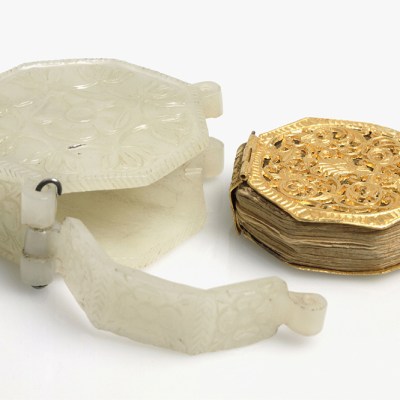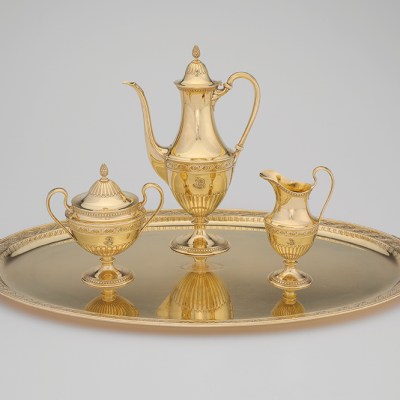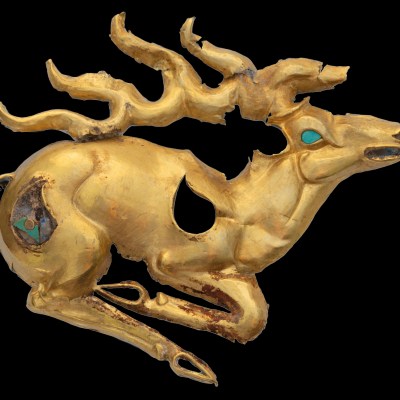From the December 2022 issue of Apollo. Preview and subscribe here.
Italian gold-ground paintings were first created to connect viewers with the foundational legends of Christendom. In a more secular age, they have also become points of contact with the foundations of Western painting – and a seasonal favourite on Christmas cards. These usually small panel paintings, employing brightly coloured tempera paint on backgrounds covered in thin sheets of gold leaf, and intended for devotional use in churches and private homes, marked the emergence of a more naturalistic painting tradition from the fixed conventions of Byzantine religious icons. They have influenced generations of painters from the Renaissance to the present day. Originally housed within intricately carved gilt wooden frames, often mimicking the surrounding architecture, since the early 19th century they have mostly been cut out and separated from their companion panels; surviving examples of private devotional works retaining their original frames are rare. The glitter of gold and the jewel-like colours of works that are atmospheric in candle-lit churches have proven equally alluring in contemporary homes and their spiritual power is undiminished.
The Mocking of Christ (c. 1280), Cimabue (Actéon, €24.2m)

What has changed, according to Eugene Pooley, a specialist in the Old Masters department at Christie’s, is that whereas 30 years ago, the popularity of these works (albeit in a niche market) stretched across the range of price and quality, today it is the very top end of the market that is most active: ‘When you get something that everyone agrees is important,’ he says, ‘bidding will go high.’ The earliest works are the most sought after, with, unsurprisingly, ‘Giotto, Duccio and Cimabue [being] the three big names.’ The most spectacular discovery of the last few years has been the small Mocking of Christ, dated to around 1280 and attributed to the Florentine Cimabue (c. 1240–1302), by whom only about 10 works are known. It was found in the kitchen of an elderly woman in northern France. In 2019 it sold through Actéon auctions, north of Paris, for €19.5m (€24.2m with fees, four times the high estimate of €6m) – a world record for a pre-1500 painting. Sold to Alvaro Saieh and Ana Guzmán, the Chilean owners of the New York-based Alana collection, France classed it a national treasure and the Louvre is in the process of acquiring it. Pooley suggests that it was the private sale through Christie’s in 2004 of the devotional panel Madonna and Child, by the Sienese painter Duccio di Buoninsegna (active by 1278–1319), from the Stoclet family in Brussels to the Metropolitan Museum of Art in New York, that marked a watershed. Its price tag of around $45m (£25m at the time) made it the most expensive object ever purchased by the museum. ‘It showed that museums were prepared to spend significant parts of their budget on gold-grounds,’ Pooley says. The sale through Sotheby’s of the left wing of a diptych by Giovanni da Rimini (active by 1292–1336) depicting episodes from the lives of the Virgin and other Saints, in London in July 2014 to the National Gallery for £5.7m (est. £2m–£3m) is further evidence. Christie’s London has some very early works coming up in its December sale, all from the Thyssen-Bornemisza Collection, including the right and left shutters of a diptych depicting The Last Judgement and The Crucifixion, by the late 13th-century painter known as the Master of the Dotto Chapel, active in Padua from 1270–1315. Estimates for both are £250,000–£350,000.
The Crucifixion (c. 1290), Master of the Dotto Chapel. Christie’s London (£250,000–£350,000)

The Last Judgement (c. 1290), Master of the Dotto Chapel. Christie’s London (£250,000–£350,000)

Edoardo Roberti, head of Old Master paintings at Sotheby’s in London, confirms that ‘people are really drawn to early pictures.’ He cites a Madonna and Child by the Third Master of Anagni, dating from the mid 1230s, which sold in London for £735,000 in 2019 (estimate £200,000–£300,000). Where the work retains its frame, and thus its original character as a three-dimensional object, there is also strong interest. A highly refined intact reliquary with paintings by Francesco di Vanuccio, including a central, small Madonna and Child, from the late 1300s, sold for just over $1m (est. $300,000–$500,000) at Sotheby’s New York in 2010.
Later works also perform well when the condition is excellent, any restoration has been sensitive, and the image is strong and, ideally, unusual. A beautifully composed Nativity by the prolific Sano di Pietro from Siena (1405–81) sold at Sotheby’s New York in January 2021 for $504,000 (est. $400,000–$600,000) and his less gold, but equally vivid Saint Donatus Chastising the Dragon sold for £759,000 (est. £500,000–£700,000) in London in 2019. The power of these simple images has increasingly attracted, Roberti suggests, ‘a whole group of cross-category buyers who are not limited by schools or genres but who are drawn by intrinsic quality’. He suggests that this ‘opening up of the conversation between objects’ has been aided by art fairs: ‘There has been something approaching a revolution in the way people buy, in the gold-ground market as much as in the antiquities market.’ He notes the ‘unexpected symbiosis of an object that is so much of its period and cultural context and yet is resonant with a contemporary aesthetic.’
This perception is confirmed by Giovanni Sarti, one of the leading dealers in the field, now based in Paris. While mourning the passing of a generation of collectors for whom these works held huge cultural significance, he notes ‘in the last few months I have seen a growing interest among younger people. They come into the gallery and are amazed that these works are for sale. They imagine they will all be in museums.’ Among his large stock, he has available an elegant panel depicting the Mystic Marriage of Saint Catherine with Saints, Cherubim and Seraphim (c. 1410–15), a rare painting by Gregorio di Cecco de Luca (active in Sienna, 1418–24). As Sarti points out, while extensive scholarship throughout the 20th century has done a great deal to establish attributions, many fine works are by still unknown or little known artists. Collectors respond to ‘the colours, the expression’, not to the name.
London-based dealer Fabrizio Moretti concurs that even the grandest names – a Giovanni da Rimini, for instance – are known only to a small group of intellectuals. ‘It is the painting that makes the difference,’ he suggests, and ‘the condition that makes the picture’. He adds, ‘It is fundamental that the gold is in good condition.’ An interesting provenance can increase the value of a good picture, but only marginally. While he notes that this is a niche market, with a small number of buyers and a small number of vendors, it is an international one, which is inevitably strongest in Europe and the United States.
Matteo Salamon of the long-established Salamon Gallery in Milan has available a beautiful Madonna and Child, a recent rediscovery by the ‘Master of 1310’, the most important artist in Pistoia before 1330. What holds the market back, in his opinion, are the export restrictions from Italy. There is inevitably a price differential between works with export licences and those without, relative to the value of the work. Recently he has had enquiries from foreign collectors willing to buy works without licences and keep them in Italy. People are mostly looking for strong narrative images, rather than the more usual Madonna and Child. Having said that, ‘the older they are, the more sought after. That has always been the case.’
From the December 2022 issue of Apollo. Preview and subscribe here.



